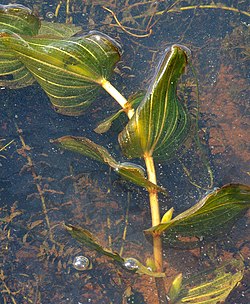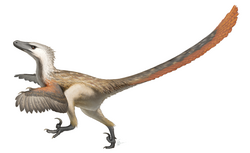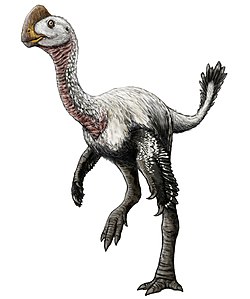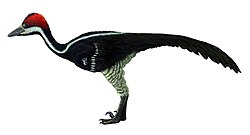| Genus | Species | Location | Stratigraphic position | Material | Notes | Image |
|---|
| Altanicypris | A. bispinifera | Altan Uul IV, Nemegt | Lower | "Complete carapace and left valve." [21] | An ostracod. | |
| A. multispina | Altan Uul IV, Nemegt | Lower | "Nine carapaces and some detached valves." [21] | An ostracod. | |
| A. szczechurae | Altan Uul IV, Nemegt | Lower | "Multiple carapaces and detached valves." [21] | An ostracod. | |
| Candona | C. altanulaensis | Altan Uul IV, Bügiin Tsav, Nemegt | | "Multiple specimens with carapaces and valves." [21] | An ostracod. | |
| cf. C. fabaeformis | Altan Uul IV, Nemegt | Lower | "Several carapaces and detached valves." [21] | An ostracod. | |
| Candoniella | C. altanica | Altan Uul IV, Bügiin Tsav, Nemegt | | "Multiple specimens with carapaces and valves." [21] | An ostracod. | |
| C. mordvilkoi | Altan Uul IV | Lower | "Three adult carapaces." [22] | An ostracod. | |
| Cyclocypris | C. transitoria | Bügiin Tsav, Nemegt | | "Seven adult carapaces." [21] | An ostracod. | |
| Cypria | C. elata | Bügiin Tsav, Hermiin Tsav | | "Several carapaces and valves." [21] | An ostracod. | |
| Cypridopsis ? | C. bugintsavicus | Altan Uul IV, Bügiin Tsav, Nemegt, Tsagan Khushu | | "Ten adult carapaces." [21] | An ostracod. | |
| Indeterminate | Nemegt | Lower | "Several complete carapaces." [21] | An ostracod. | |
| Cypris ? | C. ectypa | Altan Uul IV, Bügiin Tsav, Nemegt, Ulan Bulag | | "Complete carapaces and some detached valves." [21] | An ostracod. | |
| Cypridea | cf. C. punctilataeformis | Nemegt | | "One adult carapace." [22] | An ostracod. | |
| C. barsboldi | Altan Uul IV, Bügiin Tsav, Nemegt | | "Multiple specimens with carapaces and valves." [21] | An ostracod. | |
| C. cavernosa | Altan Uul IV, Bügiin Tsav, Nemegt, Nogon Tsav | | "Multiple specimens with carapaces and valves." [21] | An ostracod. | |
| C. rostrata | Bügiin Tsav, Nemegt, Nogon Tsav | | "Caparaces." [22] | An ostracod. | |
| Indeterminate | Altan Uul IV, Nemegt | Lower | "Five juvenile carapaces." [21] | An ostracod. | |
| Gobiella | G. prima | Altan Uul IV, Nemegt | Lower | "Several carapaces and detached valves." [21] | An ostracod. | |
| Khandia | K. stankevitchae | Altan Uul IV, Nemegt | Lower | "Multiple carapaces and valves." [21] | An ostracod. | |
| Leiria | Indeterminate | Nemegt | Lower | "Several detached valves." [21] | An ostracod. | |
| Indeterminate | Nemegt | Lower | "Complete carapace." [21] | An ostracod. | |
| Limnocythere sp. | Indeterminate | Nemegt | Lower | "Juvenile carapace." [21] | An ostracod. | |
| Lycopterocypris ? | cf. L. profunda | Altan Uul IV, Nemegt | Lower | "Multiple complete carapaces and left valve." [21] | An ostracod. | |
| Mongolianella | M. palmosa? | Altan Uul IV, Bügiin Tsav, Nemegt | | "Several adult carapaces." [21] | An ostracod. | |
| Mongolocypris | M. distributa | Altan Uul IV, Bügiin Tsav, Nemegt, Tsagan Khushu | | "Multiple specimens with complete carapaces and valves." [21] | An ostracod. | |
| Nemegtia | N. biformata | Altan Uul IV, Bügiin Tsav, Nemegt, Tsagan Khushu | | "Multiple complete carapaces and several detached valves." [21] | An ostracod. | |
| N. obliquecostae | Altan Uul IV, Nemegt | Lower | "Multiple carapaces and valves." [21] | An ostracod. | |
| N. reticulata | Altan Uul IV, Bügiin Tsav, Nemegt, Nogon Tsav, Tsagan Khushu | | "Several carapaces and detached valves." [21] | An ostracod. | |
| Paracypridea ? | P. mongolica | Altan Uul IV, Nemegt | Lower | "Multiple carapaces and detached valves." [21] | An ostracod. | |
| Rhinocypris sp. | Indeterminate | Nemegt | Lower | "Several carapaces." [21] | An ostracod. | |
| Scabriculocypris | S. ingenicus? | Altan Uul IV, Bügiin Tsav, Naran Bulag, Nemegt, Tsagan Khushu | | "Multiple carapaces and valves." [21] | An ostracod. | |
| S. rasilis? | Altan Uul IV, Nemegt | Lower | "Several carapaces and detached valves." [21] | An ostracod. | |
| Timiriasevia | cf. T. miaogouensis | Altan Uul IV, Nemegt | Lower | "Seven valves." [21] | An ostracod. | |
| cf. T. opinabilis | Altan Uul IV | Lower | "Adult carapace." [22] | An ostracod. | |
| T. minuscula | Altan Uul IV, Bügiin Tsav, Nemegt | | "Multiple specimens with carapaces and valves." [21] | An ostracod. | |
| T. naranbulakensis | Altan Uul IV, Bügiin Tsav, Nemegt | | "Four carapaces and one right valve." [21] | An ostracod. | |
| Ziziphocypris | Z. costata | Altan Uul IV, Bügiin Tsav, Nemegt | | "Fourteen carapaces." [21] | An ostracod. | |
|

















































